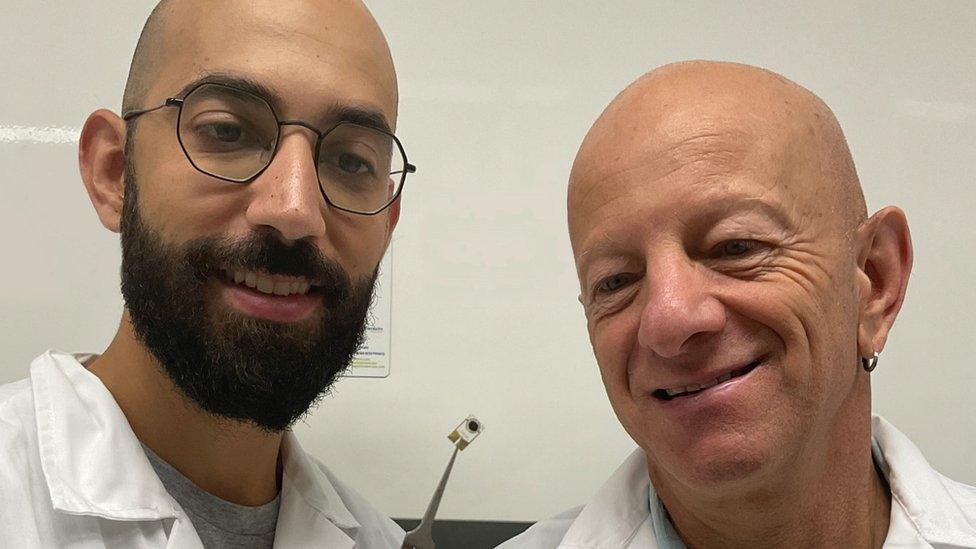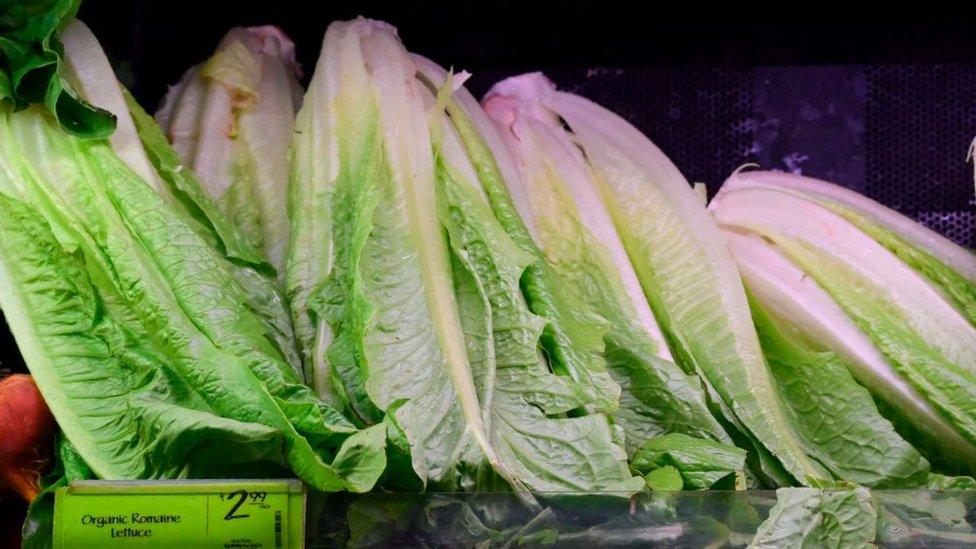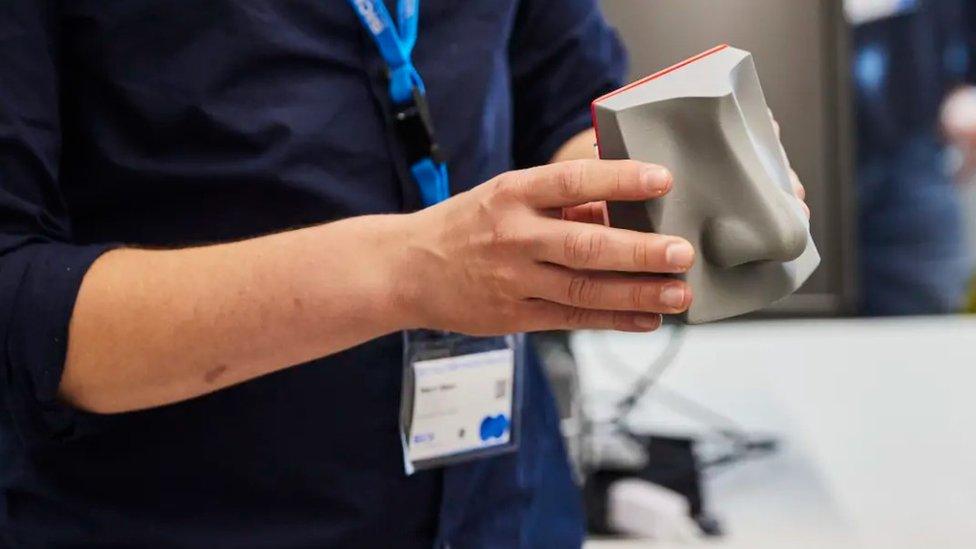The electronic noses designed to prevent food poisoning
- Published

Raz Jelinek, right, and his student Nitzan Shauloff, show off one of their e-nose sensors
The human nose and its ability to smell is an amazing thing.
Each nose has around 400 scent receptors that are said to be able to detect around one trillion different odours., external
To replicate such a level of sensory expertise in scientific equipment is a daunting challenge.
Yet thanks to recent advances in artificial intelligence (AI), the latest electronic noses - high-tech sensors that can detect and report specific smells - are quickly improving their levels of speed and accuracy.
Their proponents say that they can transform food safety.
Common types of potentially deadly foodborne bacteria are salmonella and E. Coli. Both of these have their own "electronic personality", says Prof Raz Jelinek, the co-developer of an e-nose called Sensifi, and a professor of chemistry at Ben Gurion University of the Negev, in Israel. "They have their own electrical signal."
The e-noses made by the Israeli company of the same name contain electrodes that are coated with nanoparticles of carbon. They detect the smells or volatile organic compounds (VOC) given off by bacteria.

Contaminated romaine lettuce is said to be one of the biggest causes of food poisoning
Different strains of bacteria produce a different VOC fingerprint, which in turn creates a different electric signal in the Sensifi machine. This is then recorded by an AI software system, which checks it against its ever-growing database, and notifies the user.
Sensifi, which launched earlier this year, hopes that it can transform the fight against infection in the food industry. Its chief executive Modi Peled says that in most cases food producers currently have to send samples off to a laboratory for testing, and then wait a number of days for the results to come back.
By contrast, Sensifi's e-noses can be used on site by the food firms themselves, and are said to give their results in less than one hour. It hasn't released a price for its machines, but says they will be "low cost". The firm instead intends to make most of its money from subscription fees.
"Testing methods in the food industry have remained the same for 40 to 50 years," says Mr Peled. "Until now AI hadn't really entered the testing segment of this market."


Food poisoning remains a serious problem around the world. In the US, 48 million people, or one in six, get sick every year from a foodborne illness., external Of these, 128,000 are hospitalised, and 3,000 people die.
In the UK, it is calculated that there are 2.4 million cases of food poisoning every year, , externaland an estimated 180 deaths., external
"People would say that meat, poultry and fish are the main culprits," says Mr Peled. "But if you look at the biggest killer in the US food industry in the last five to 10 years, it is the romaine lettuce.
"And the more the food market is being industrialised, the more it will be susceptible to pathogens."
At German firm NTT Data Business Solutions it had a novel way to help train the AI that powers the e-nose it is developing - coffee.
In one test, technicians spent three days putting instant coffee powder next to the AI's sensors. The AI then had to identify one of three options - good coffee, bad coffee (coffee that had been laced with vinegar), and no coffee at all.
"An odour isn't just a gas, it is a unique combination of gases," says Adrian Kostrz, the firm's innovation manager. "And very often there are variations or very small differences in the way things smell."
NTT's sensors are fitted to a 3D-printed plastic model of a human nose. It is training its AI with coffee and other foodstuffs to enable it to know what they are meant to smell like when they are fresh and in good condition, which the firm says is "the reference value of an odour".

NTT's sensors are fitted inside a 3D print out of a human nose
The idea is that NTT's e-nose can be used not just to sniff out any contagions, but also how fresh - or not - a foodstuff is. This will help enable supermarkets or cafes to know what to sell first when something doesn't come with best-before dates.
"Knowing the reference value of an odour would help the food industry to adapt its production, storage, harvesting and processes accordingly," adds Mr Kostrz.
However, some AI experts say that while the latest e-noses work well, they are unlikely to see significant demand, because food firms are likely to be put off by the cost.
"If you're talking about deploying a worldwide network of small detectors, from the picking to storage, to delivery, you have to consider how that's going to impact the business model," says Vincent Peters, founder and chief designer of US-based AI research firm Inheritance AI.
"Will there still be a business if you have to deploy and sustain that technology? Will the supply chain management actually implement it? Will there be a profit margin?"
Meanwhile, fellow AI expert, Kjell Carlsson of San Francisco-based Domino Data Lab, says that the e-noses would need complicated fine tuning for each facility they were working at. "This is an extraordinarily difficult task in an industry not known for embracing new technologies," he says.
However, such scepticism is not discouraging some entrepreneurs.
In New Zealand, a company called Scentian Bio, says it has copied the antennae of insects to develop its "biosensors". This has seen it replicate insect proteins, and include them in its scent sensors.
Andrew Kralicek, founder and chief technology officer of the firm, says that as a result of this biotechnology its sensors are "thousands of times more sensitive than a dog's nose".
He adds: "We can use this biosensor-based tech virtually everywhere - in food and flavour quality control, food pathogen detection, non-invasive rapid disease diagnosis, sustainable farming, and environmental and wellness monitoring."